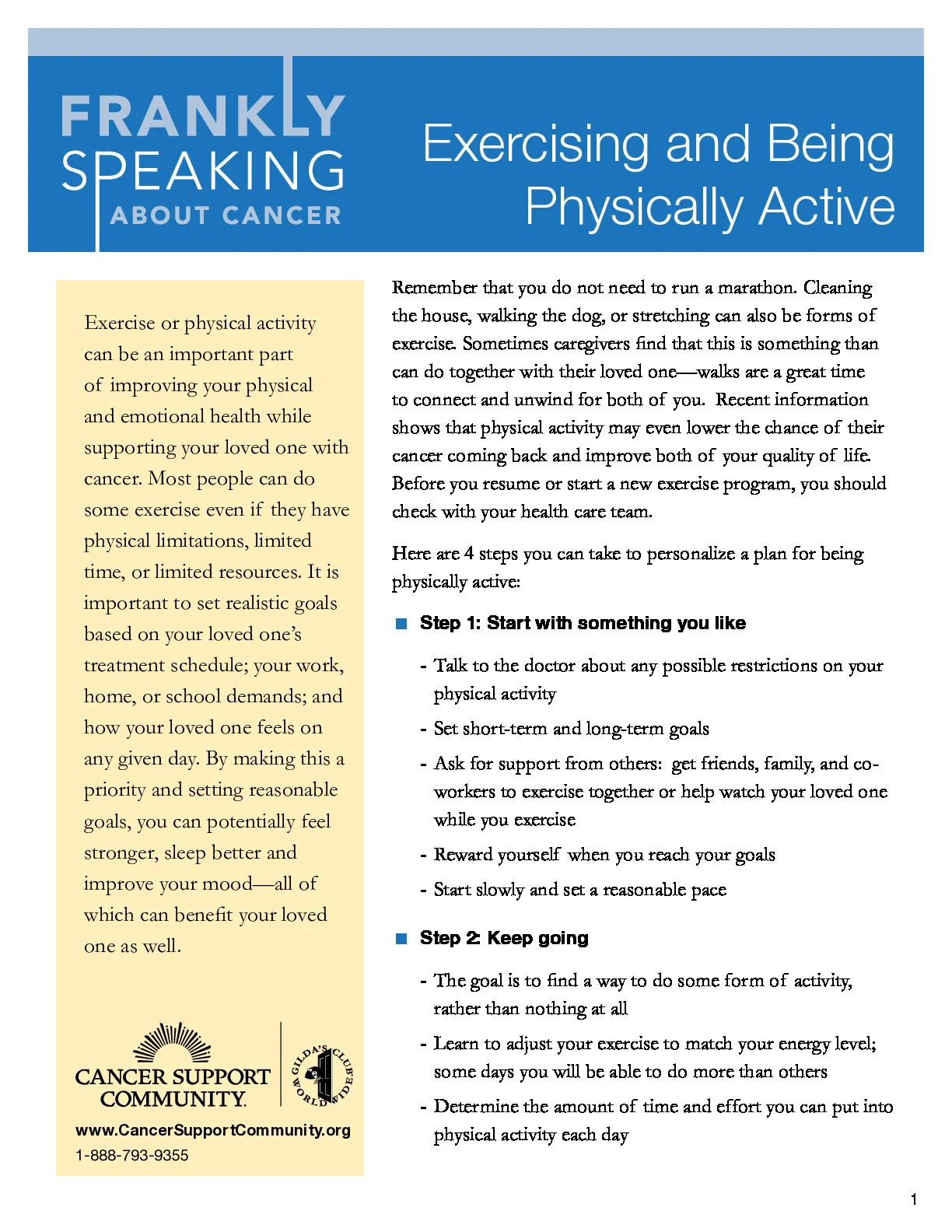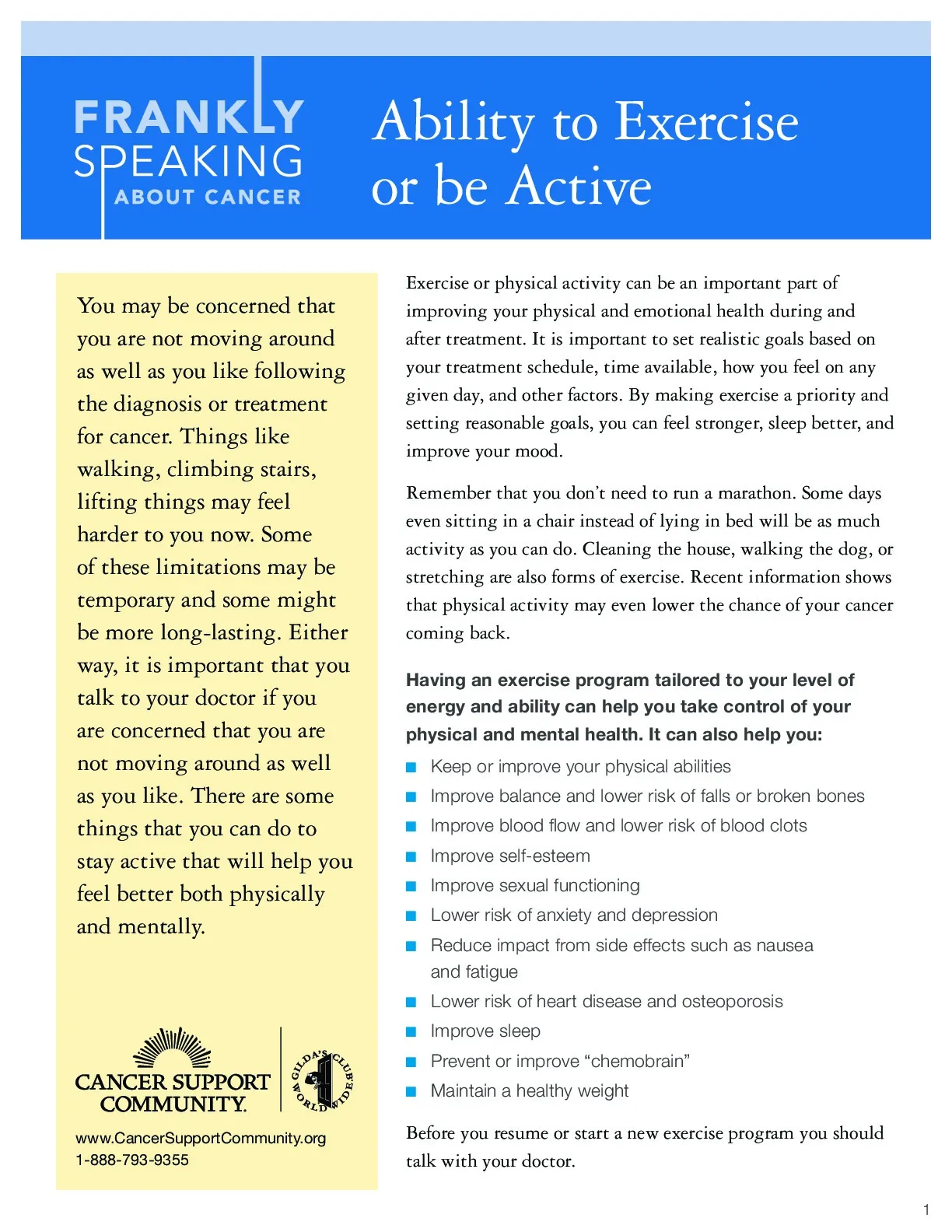Exercise for Wellness
Table of Contents
Benefits of Exercise
Exercise is a powerful tool that can help you take control of your physical and mental health. An exercise program tailored to your level of energy and ability can help you:
- Keep or improve your physical abilities
- Improve balance and lower risk of falls or broken bones
- Improve blood flow and lower risk of blood clots
- Improve self-esteem
- Improve sexual functioning
- Lower risk of anxiety and depression
- Reduce impact from side effects such as nausea and fatigue
- Lower risk of heart disease and osteoporosis
- Improve sleep
- Help prevent or improve cognitive symptoms
- Help maintain a healthy weight
Regular exercise can improve your health and quality of life but it is important to develop an exercise program that is right for you. Your energy and fitness may be very different after treatment. Talk with a member of your health care team or your physical therapist if you have questions or need additional advice.

ACE Your Workout
After completing your workout, use this test to decide whether you aced your workout.
When you A.C.E your workout, you will feel:
- Alert – mentally
- Calm – emotionally
- Energized – physically
When you ACE your workout, you feel better after exercise than you did before. That’s part of the magic of exercise. Exercise can improve the way you feel, even when you are a little sick, tired, or sad. Be sure to customize your exercise to match how your body is doing on a given day.
If you feel mentally tired, emotionally upset, or physically exhausted, you probably overdid it. If you feel bored or uninspired, you probably didn’t do enough. Make changes for next time, and keep moving.
Maintain Your Exercise Plan
Once you establish an exercise routine that fits your body and your schedule, start thinking about how to keep exercise in your life. Three simple steps have helped many people stick with healthy lifestyle changes, whether it is losing weight, exercising regularly, or quitting smoking.
Set Realistic Goals
Doing too much can be frustrating and use up more energy than it creates. Doing too little can make exercise boring and not give you much energy either. Customize your workout to make sure that you get the most benefit from exercise.
A good rule of thumb to remember is to make your goals S.M.A.R.T.
- S – Set SPECIFIC goals because general goals are much harder to achieve.
- M – Set MEASURABLE goals since goals are easier to work on when you have something to work toward.
- A – Set ATTAINABLE goals that make sense for you and your current lifestyle.
- R – Set REALISTIC goals that are doable for you at this stage in your cancer journey.
- T – Set TIMELY goals that have a time frame to help you stay on track.
Reward Yourself
Making time for exercise can be hard. Come up with some simple rewards you can give yourself to make it more fun. A reward can be anything that feels like a treat to you — a call to a friend, a book, an extra 5 minutes in bed in the morning, or something special like tickets to a show or sporting event. You can reward yourself for 1 workout, 3 workouts, or a week or month of regular exercise. Keep track in a exercise log if it is helpful. Do what works for you. Vary the rewards so you stay interested and motivated to meet your goals.
Note: Some experts tell people who are trying to lose weight not to use food as a reward. If you must use food rewards, choose a small treat. A reward should never be a food that a doctor has told you to avoid for health reasons.
Establish a Support System
Find a friend or exercise buddy to help you keep moving. Tell your family and friends what you are doing so they can support you. Identify some rewards that your family, friends, or buddy can share with you.
For additional support, you can also call our Cancer Support Helpline at 888-793-9355, or use our Helpline's live chat service, Monday-Friday, 9 a.m.-9 p.m. ET, and Saturday-Sunday, 9 a.m.-5 p.m. ET.
Everyone’s Human: What To Do If You Fall Off the Exercise Wagon
Even Olympic athletes take a break, by necessity or choice. You may have to let some ailments run their course, or keep your feet up while an injury heals. Maybe you were traveling, or life became overwhelming for a while.
If you had been exercising and stopped, for any reason: skip the guilt. Instead, remember why you started exercising, remember the gains you made and recommit yourself to an exercise plan.
Go back to the basics. Set goals suitable to where you are now and work back to where you were. Each day that you exercise is a day that you do something good for yourself. It is helpful to understand what got you off track — then look forward, not back, and take one day at a time. Remember to reward yourself and record your results in an exercise log. Stick with it, and you will be ACE-ing your workouts again in no time!

Customize Your Workout Plan
Exercise is an important part of staying healthy before, during and after cancer. You will feel very different on the day after you complete treatment than you will a few months or years later. The way you exercise needs to be different too. Learn how to customize your exercise routine to match your energy and fitness level.
Customized exercise is about changing an exercise movement to fit what you can do and how you feel on a given day. This is sometimes called tailoring your exercise routine.
Start by choosing a form of exercise. There are many different ways to stay active. Find an activity you might enjoy and adapt it to match your abilities. The following suggestions will help you read how you feel at any given moment, then customize your chosen exercise to match your feeling. Use these 5 steps to customize your workout.
Step I: Customize
If it feels good, do it! If it feels bad, customize it! This movement motto works for all levels and abilities. You can replace the word “good” with safe or comfortable and the word “bad” with unsafe or uncomfortable. If it feels safe or comfortable, do it. If it feels unsafe or uncomfortable, customize it. Keep these things in mind:
- If you feel sick, exercise may help decrease nausea. Exercise when you feel sick should be gentle, slow, and brief.
- If you are fatigued or extremely tired, gentle, brief exercise may give you energy. You can always do more on a day when you are less tired.
- If you are not sleeping well at night, exercise during the day may help you sleep better.
Step II: Keep Moving
Your goal is to move in a way that works for you. Instead of saying “I can’t,” learn to say, “I can.” Figure out how to customize movements so they feel good. Keep trying little changes until you find the action that is right for your body. Remind yourself that it does not matter what others are doing or what you used to do in the past. Your muscles, level of fatigue, nausea and bone strength may be different now. Anything you do to improve your current physical health will be valuable.
Step III: Energy – Aim for Gain vs. Drain
How do you customize your exercise? Start by deciding how much time and effort you can put into exercise each day based on how you feel that day. Then work on doing the movement in a way that feels good. Adjust the movements as you go along so that they feel good and safe to you. Aim to keep moving during your exercise time.
Choose Your Energy Level
Determine your level of energy. Use a scale from 0 to 10, with 0 being absolutely no energy and 10 being totally energetic. Choose the length of time or type of exercise you are doing today based on your energy level. Keep a short list of different workouts for different levels of energy. For example, you may have one workout you do when you are feeling 0-2, another for when you are feeling 8-10, and others for those days in between. The purpose is to work with your body, not against it. You want to exercise at your capacity, not below it or above it. Exercise should help you gain, not drain, energy.
Choose Your Fitness Level
A healthy exercise program needs to match your fitness level. Here is an example of how you tailor exercise for your fitness level.
- Low fitness: Walk at a comfortable pace for 10 minutes around a mall or your neighborhood. Bring a friend and make sure you can talk as you walk.
- Intermediate fitness: Walk at a brisk pace, increasing walking time by 5 minutes every day or 2. Use music with a good beat in a personal music player to help you increase your speed and time.
- High fitness: Add weights, power-walk, jog, or run. Work on increasing distance, time, and speed.
Step IV: Talk Test
While you exercise, take a moment to notice if you are working too hard. Try talking in full sentences. If you can talk in full sentences without getting short of breath, you are working at a safe level. If you cannot talk in full sentences without getting short of breath, you are working too hard, and maybe even at unsafe levels.
Step V: Deep Breathing – Low and Slow
Learn to breathe low in your belly, at a slow pace. Deep breathing relaxes tension and energizes you. Oxygen allows your muscles to work. The goal is to feel good, be safe, and gain energy!

Visit Our Mind Body Studio
Our mind body studio offers yoga lessons, gentle exercises, and meditation videos specifically designed with the needs of people impacted by cancer.
Frankly Speaking About Cancer Library
LibraryWould you like a print copy of these educational materials?
We can mail our Frankly Speaking About Cancer pieces to you. Shipping is free for up to 20 pounds.

